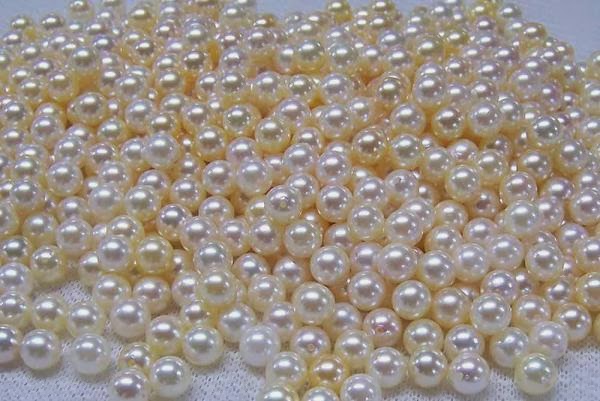Marine products
The Beibu
Gulf (北部湾, Gulf of Tonkin) that neighbors Beihai has abundant marine resources,
and it is one of the four major fisheries in China. Typical products include pearls,
sea cucumbers, peanut worms (Sipuncula), prawns, abalones, groupers, crabs,
cuttlefish, oysters and various shellfish. The pearl from Hepu (合浦) is also called Nanzhu (南珠, South Pearl), and it is known as the
queen of the seawater pearls of China. Nanzhu was sent as tribute to the court of the emperor since the Qin dynasty. There is also a story called "珠还合浦" (Chinese idiom).
Handicrafts
Handicrafts
include ox horn carving (牛角雕), shell carving (贝雕), bamboo weaving (竹藤编织工艺品), etc.
Ox horn
carving is the characteristic sculpture of Hepu that uses ox horn as the raw
material. There are two kinds of ox horns, Mingjiao (明角) and Heijiao (黑角). The buffalo horn from Guangxi
is of high quality, and especially the Mingjiao has a sheen like jade and is
very solid. The horn after processing is translucent and has a smooth surface, and
it can even be as fine as hair or as thin as paper.
Shell
carving is elaborately designed by the handicraftsman who can make good use of
the natural color, shape, pattern of shells. The shell carving from Beihai is
divided into 6 types: large relieve (大型浮雕作品), carving picture (贝雕画), carving Baijian (贝雕摆件)[1], carving Bajian (贝雕把件), stereoscopic carving (立体贝雕), ornament (贝雕饰品). The most famous carving is a huge mural named "the history of
the transition of golf" (高尔夫之传承史). The mural is made of more than 40 kinds of sea shells, such as Baidiebei (白蝶贝), Heidiebei (黑蝶贝), Huangguangluo (黄光螺), Baiyujialuo (白玉甲螺), Litouluo (犁头螺), etc. It is 18.03 m long, 2.58 m wide
and currently the largest shell carving mural in China.
Agricultural products
There are
Xiangshan Jizui Lizhi (香山鸡嘴荔枝, a kind of lychee), longan (龙眼), Baisha Guozhe (白沙果蔗, a kind of sugarcane), Yongan
Huangpiguo (永安黄皮果, Clausena lansium). Those are
well-known in Beihai.
Xiangshan
Jizui Lizhi comes from Xiangshan Village (香山村), Gongguan Town (公馆镇), Hepu County (合浦县), and it has 300 or 400 years of history of cultivation.
The name comes from the seed that is small and looks like the beak of chicken. The
size is relatively big, and the flesh is thick and has a fresh, sweet taste.
Longan
ripens in Guiyue (桂月, the 8th month of the lunar year)
and is round in shape, so it is also called "Guiyuan" (桂圆). The history of cultivation in Hepu is over a thousand years. And the
ones from Xichang Town (西场镇) are the most famous. They feature big size, thin peel, strong sweetness, and the dried flesh called "Yuanrou"
(圆肉) can also be used as medicine. Su Dongpo (苏东坡), the great litterateur of the Northern Song Dynasty, was full of
praise for the longan from Hepu and composed a poem.
Baisha
Guozhe comes from the area of Caojiang (草江) and Longjiang (龙江), Baisha Town (白沙镇), Hepu County, and it has nearly
a century of history of cultivation. The peel and flesh is soft, and it is more
juicy and less sweet, compared with the common sugarcane. Guozhe is also used as a traditional
Chinese medicine and has the effects of "清热", "生津", "润燥".
Huangpiguo,
also known as "wampee", is similar to longan at first glance, however
the shape, peel, seed, and even the effect as a medicine is all different. It is a fruit
that Beihainese people (北海人) prefer in summer, and it not only has high nutritive value but its leaves and seeds can also be used as medicine. In particular, the ones from
Yongan Village (永安村), Shankou Town (山口镇), Hepu County are well known for a long history of cultivation.
Others
Beihai is
one of the manufacturing bases of fireworks in China and has more than 200 years
of history. The local people also celebrate holidays with fireworks. The
firecracker has a feature of clear and loud sound, and there are over 200
varieties of fireworks. About two thirds of the products are exported to over
20 countries and regions, such as America, Japan, Southeast Asia, and they have
been greatly welcomed by the people all over the world.
There is
also an alcoholic beverage called "Dongyuanjiajiu" (东园家酒). It comes from the Huang family's secret recipe from a restaurant in
Hepu called Dongyuan, and it has over 100 years of history. The beverage is made by
refining the liquid after a long time of soaking over 30 kinds of crude drugs in
slightly steamed pure Mijiu, such as Zhenzhuluorou (珍珠螺肉, the meat of Zhenzhuluo[2]), seahorse (海马), seaweed pipefish (海龙, Syngnathus), sea snake (海蛇, Hydrophiinae), Lujin (鹿筋, deer's sinew), Lubian (鹿鞭, deer's penis), Guiban (龟板, tortoise shell), Dilong (地龙, earthworm), Gejie (蛤蚧, gecko), Guiyuan (桂圆, longan), Duzhong (杜仲, Cortex Eucommiae), Yinyanghuo (淫羊藿, Herba Epimedii), etc. It has a low percentage of alcohol and a good
taste, and it is nutritious and good for health.
1. The term "Baijian" (摆件) denotes a large-sized ornamental exhibit that is over 350 g. And "Bajian"
(把件) denotes a small-sized one that is 30-200 g and can be played with in
hand.
2. Zhenzhuluo (珍珠螺), also called "Jiemeiluo" (姐妹螺), is a kind of pearl oyster and
one of the regional specialties of Beihai.















没有评论:
发表评论